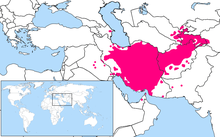Pahlavani language
| Persian | |
|---|---|
| Fārsi | |
| فارسی | |

Fārsi written in Persian (Nastaʿlīq script)
|
|
| Pronunciation | [fɒːɾˈsiː] |
| Native to |
|
|
Native speakers
|
45 million (2007) – 60 million (2009) (110 million total speakers) |
|
Indo-European
|
|
|
Early forms
|
|
|
Standard forms
|
|
| Dialects | |
| Official status | |
|
Official language in
|
|
| Regulated by | |
| Language codes | |
| ISO 639-1 | fa |
| ISO 639-2 |
(B) (T)
|
| ISO 639-3 |
Individual codes: pes – Western Persian prs – Dari language (Afghan Persian) tgk – Tajiki aiq – Aimaq dialect bhh – Bukhori dialect haz – Hazaragi dialect jpr – Judeo-Persian phv – Pahlavani deh – Dehwari jdt – Judeo-Tat ttt – Caucasian Tat |
| Glottolog | fars1254 |
| Linguasphere |
58-AAC (Wider Persian) |

Areas with significant numbers of Persian speakers (including dialects).
|
|

Countries where Persian is an official language.
|
|
Persian (/ˈpɜːrʒən/ or /ˈpɜːrʃən/), also known by its endonym Farsi (فارسی fārsi [fɒːɾˈsiː]), is one of the Western Iranian languages within the Indo-Iranian branch of the Indo-European language family. It is primarily spoken in Iran, Afghanistan (officially known as Dari since 1958), and Tajikistan (officially known as Tajiki since the Soviet era), and some other regions which historically were Persianate societies. It is mostly written in the Persian alphabet, a modified variant of the Arabic script.
The Persian language is classified as a continuation of Middle Persian, the official religious and literary language of the Sasanian Empire, itself a continuation of Old Persian, the language of the Achaemenid Empire. Its grammar is similar to that of many contemporary European languages. Persian gets its name from its origin at the capital of the Achaemenid Empire, Persis (modern-day Fars Province), hence the name Persian (Farsi). A Persian-speaking person may be referred to as Persophone.
...
Wikipedia
